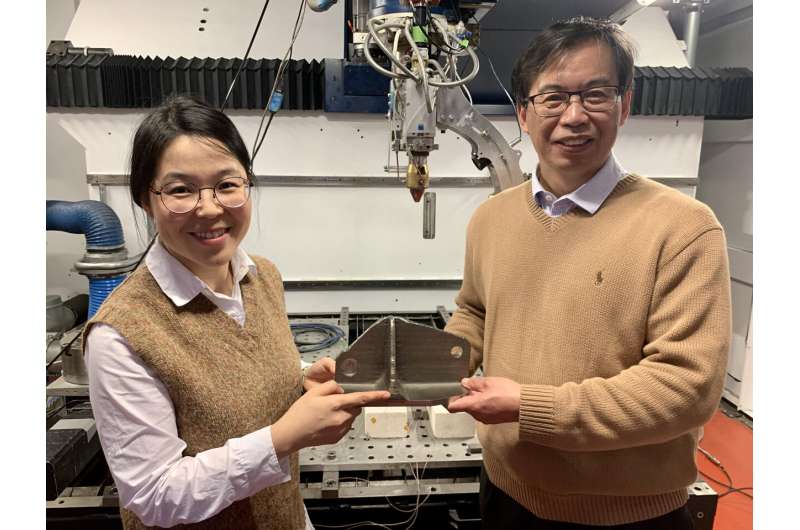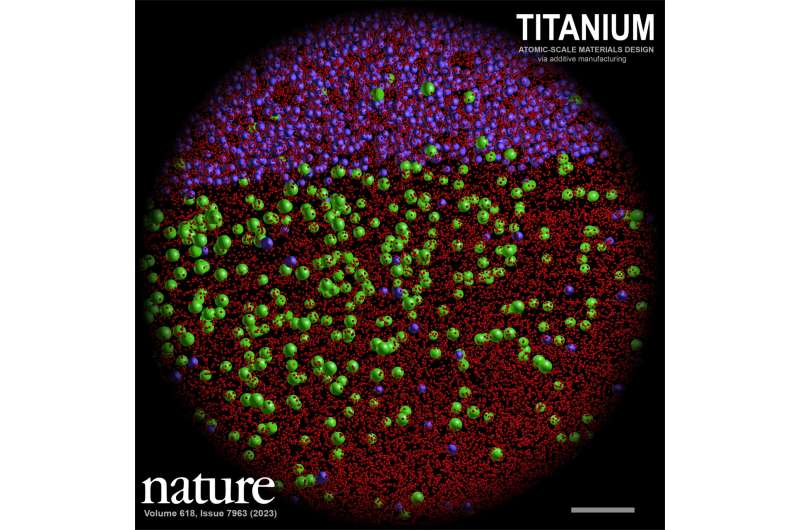This article has been reviewed according to Science X's editorial process and policies. Editors have highlighted the following attributes while ensuring the content's credibility:
fact-checked
peer-reviewed publication
trusted source
proofread
New 'designer' titanium alloys made using 3D printing

A team of researchers has created a new class of titanium alloys that are strong and not brittle under tension, by integrating alloy and 3D-printing process designs.
The breakthrough, published in the journal Nature, could help extend the applications of titanium alloys, improve sustainability and drive innovative alloy design.
Their discovery holds promise for a new class of more sustainable high-performance titanium alloys for applications in aerospace, biomedical, chemical engineering, space and energy technologies.
RMIT University and the University of Sydney led the innovation, in collaboration with Hong Kong Polytechnic University and the company Hexagon Manufacturing Intelligence in Melbourne.
Lead researcher, Ma Qian a professor from RMIT, said the team embedded circular economy thinking in their design, creating great promise for producing their new titanium alloys from industrial waste and low-grade materials.
"Reusing waste and low-quality materials has the potential to add economic value and reduce the high carbon footprint of the titanium industry," said Qian from RMIT's Center for Additive Manufacturing in the School of Engineering.
What type of titanium alloys has the team made?
The team's titanium alloys consist of a mixture of two forms of titanium crystals, called alpha-titanium phase and beta-titanium phase, each corresponding to a specific arrangement of atoms.
This class of alloys has been the backbone of the titanium industry. Since 1954, these alloys have been produced primarily by adding aluminum and vanadium to titanium.
The research team investigated the use of oxygen and iron—two of the most powerful stabilizers and strengtheners of alpha- and beta-titanium phases—which are abundant and inexpensive.

Two challenges have hindered the development of strong and ductile alpha-beta titanium-oxygen-iron alloys through the conventional manufacturing processes, Qian said.
"One challenge is that oxygen—described colloquially as 'the kryptonite to titanium'—can make titanium brittle, and the other is that adding iron could lead to serious defects in the form of large patches of beta-titanium."
The team used Laser Directed Energy Deposition (L-DED), a 3D printing process suitable for making large, complex parts, to print their alloys from metal powder.
"A key enabler for us was the combination of our alloy design concepts with 3D-printing process design, which has identified a range of alloys that are strong, ductile and easy to print," Qian said.
The attractive properties of these new alloys that can rival those of commercial alloys are attributed to their microstructure, the team says.
"This research delivers a new titanium alloy system capable of a wide and tunable range of mechanical properties, high manufacturability, enormous potential for emissions reduction and insights for materials design in kindred systems," said co-lead researcher University of Sydney Pro-Vice-Chancellor Professor Simon Ringer.
"The critical enabler is the unique distribution of oxygen and iron atoms within and between the alpha-titanium and beta-titanium phases.
"We've engineered a nanoscale gradient of oxygen in the alpha-titanium phase, featuring high-oxygen segments that are strong, and low-oxygen segments that are ductile allowing us to exert control over the local atomic bonding and so mitigate the potential for embrittlement."
What are the potential applications of the research findings?
Lead author Dr. Tingting Song, RMIT Vice-Chancellor's Research Fellow, said the team is "at the start of a major journey, from the proof of our new concepts here, towards industrial applications."
"There are grounds to be excited—3D printing offers a fundamentally different way of making novel alloys and has distinct advantages over traditional approaches," she said.
"There's a potential opportunity for industry to reuse waste sponge titanium-oxygen-iron alloy, 'out-of-spec' recycled high-oxygen titanium powders or titanium powders made from high-oxygen scrap titanium using our approach."
Co-lead author Dr. Zibin Chen, who joined Hong Kong Polytechnic University from the University of Sydney in the later stages of the collaboration, said the research had broader implications.
"Oxygen embrittlement is a major metallurgical challenge not only for titanium, but also for other important metals such as zirconium, niobium and molybdenum and their alloys," he said.
"Our work may provide a template to mitigate these oxygen embrittlement issues through 3D printing and microstructure design."
The team's work benefited from sustained, targeted investment in research infrastructure from national and state governments and from universities, Ringer said.
"In many ways, this work showcases the power of Australia's national collaborative research infrastructure strategy and sets the scene for extending this strategy into the realm of advanced manufacturing," he said.
The team's research paper, "Strong and ductile titanium-oxygen-iron alloys by additive manufacturing," is published in Nature.
An editorial on the team's work, "Designer titanium alloys created using 3D printing," is also published in Nature.
More information: Ma Qian, Strong and ductile titanium–oxygen–iron alloys by additive manufacturing, Nature (2023). DOI: 10.1038/s41586-023-05952-6. www.nature.com/articles/s41586-023-05952-6
Editorial: Designer titanium alloys created using 3D printing, Nature (2023). DOI: 10.1038/d41586-023-01360-y




















